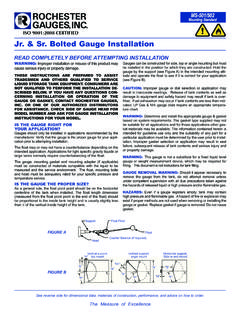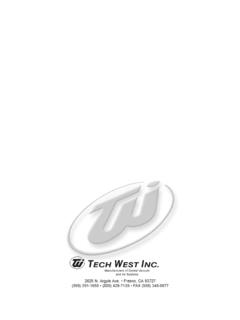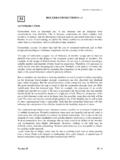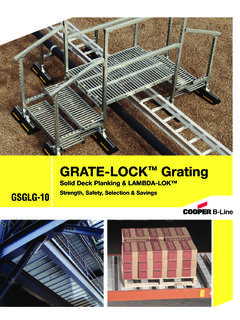Transcription of Installation, Operation, & Maintenance …
1 Tube & Coil Products, Inc Hamden, CT 06517 Ph: (800) 824-2664 Web: - 1 - installation , Operation, & Maintenance instructions For JFD Shell & Tube Heat Exchangers Manufactured For: _____ JFD Serial Number(s): _____ JFD Order Number: _____ Tube & Coil Products, Inc Hamden, CT 06517 Ph: (800) 824-2664 Web: - 2 - Introduction This manual will cover Shell & Tube type heat exchangers, of U-Tube, Fixed Tube Sheet, Floating Rear Tube Sheet, and Double Tube design. The Heat Exchanger discussed in this manual has been carefully assembled and factory tested to provide years of trouble-free service. In order to assure the service intended, the following information is provided to enable proper installation , Operation, and Maintenance of the JFD Heat Exchanger.
2 Storage If the heat exchanger cannot be installed immediately upon receipt at the job site, please be advised of certain necessary precautions to prevent deterioration during storage. Responsibility for integrity of the heat exchanger is to be assumed by the User. JFD Tube & Coil Products, Inc. will not be responsible for damage, corrosion, or other wear & tear of equipment during storage. Upon receipt of the heat exchanger, inspect for shipping damage. If damage is evident, inspect for possible contamination and replace protective covers as needed. If damage is extensive, notify the Freight Carrier and JFD immediately. Remove any accumulations of dirt, water, ice, or snow and wipe dry before moving the exchanger into indoor storage. Take precautions to prevent rusting or contamination.
3 Open drain plugs to remove any moisture, then reseal. Store under cover in a climate controlled area, if possible. An ideal storage environment is a dry, low humidity area that is sealed to prevent entry of blowing dust, rain, or snow. Inspect the heat exchanger frequently while it is in storage. installation Location The heat exchanger should be located in a clean, open area, with sufficient clearance at the head of the heat exchanger to remove the tube bundle. In the case of Fixed Tube Sheet units, allow room on both ends of the unit to remove the heads for inspection and tube cleaning. In the case of Floating Rear Tube Sheet units, allow sufficient space at the stationary head end to remove the tube bundle, and sufficient space at the floating head end to permit removal of the shell cover and/or floating head cover.
4 The foundation of the heat exchanger should be adequate so that the unit will not settle and cause piping strains. Foundation bolts should be set to allow for settling inaccuracies. In concrete footings, pipe sleeves at least one size larger than the bolt diameter slipped over the bolt and cast in place are best for this purpose, as they allow the bolt center to be adjusted after the foundation has set. Foundation bolts should be loosened at one end of the unit to allow for free expansion and contraction of the heat exchanger shell. Slotted holes are provided for this purpose. Exchangers should be set level and square so that pipe connections can be made without forcing. Fittings & Piping Provide valves and bypasses in the piping system so that both the shell-side and the tube-side may be bypassed to permit isolation of the unit for inspection and repairs.
5 Long radius elbows should be used in lieu of standard elbows wherever possible, because of their superior flow characteristics. Tube & Coil Products, Inc Hamden, CT 06517 Ph: (800) 824-2664 Web: - 3 - When not integral with the exchanger nozzles, thermometer well and pressure gauge connections should be provided in all piping to and from the unit, and located as close to the unit as possible. Vent valves should be provided so units can be purged to prevent vapor or gas binding. Special consideration must be given to discharge of hazardous or toxic fluids. Drain connections should not be piped to a common closed manifold. In all installations, care should be taken to eliminate or minimize transmissions of fluid pulsations and mechanical vibrations of the heat exchanger.
6 Quick-opening and closing valves controlling fluids to or from the heat exchanger may cause water or steam hammer, which can cause serious damage to the heat exchanger. Cleanliness Provisions All heat exchanger openings should be inspected for foreign material. Protective plugs and covers should not be removed until just prior to installation . The entire system should be cleaned before starting operation. Under some conditions, the use of strainers in the piping may be required. Convenient means should be provided for cleaning the unit as suggested in the Maintenance section. Operation of Heat Exchanger Design & Operating Conditions Equipment must not be operated at conditions which exceed those specified on the name plate(s). Bolted Joints Heat exchangers are pressure tested at JFD s facility in accordance with ASME Code requirements.
7 However, normal relaxing of the gasketed joints may occur in the interval between testing and installation at the job site. Therefore, all external bolted joints should be properly retightened (see diagram on page 8) after installation , and again after the unit has been heated. This is to prevent leaks and gasket blowout. Operation Procedures -- Before placing any heat exchanger in operation, reference should be made to the exchanger drawing(s), specification sheet(s), and name plate(s) for any special instructions . Local safety and health regulations must be considered. Improper start-up or shut-down sequences, particularly of Fixed Tube Sheet and Double Tube units, may cause leaking of the tube-to-tube sheet and/or bolted flange joints.
8 Start-Up Operation When placing a unit in operation, open all vent connections and start to circulate the cold media only. Be sure the cold side of the unit is entirely filled with fluid before closing the vents. The hot media should then be introduced gradually until all passages are completely filled with liquid or vapor, whichever the case may be. Then close the vents and slowly bring the unit(s) up to temperature. Start operation gradually. Do not subject the heat exchanger to sudden temperature fluctuations. Hot fluid must not be suddenly introduced when the unit is cold, or vice-versa. This could damage the exchanger and void the warranty. For Fixed Tube Sheet units, fluids must be introduced in a manner to minimize differential expansion between the shell & the tubes.
9 For Double Tube units, see the following page for Special instructions . Tube & Coil Products, Inc Hamden, CT 06517 Ph: (800) 824-2664 Web: - 4 - Recommended Procedure for Flooding Intermediate Zone with Glycol in Double Tube Safety Heaters 1. With Heat Exchanger completely assembled, remove and MPT plugs from sight indicator and vent connections. These connections should be at the highest point in relation to the heat exchanger shell. 2. Fill the FNPT connection with 100% Ethylene Glycol. The connection acts as a vent. 3. Let stand 30 minutes. 4. Install sight window in the FNPT connection. Then top off with glycol through the connection. Vent remaining air by gradually turning on the hot-side media. Once all air has vented out, and glycol begins to bubble out, tighten FNPT connection and plug.
10 Then gradually introduce the cold-side media, and bring the unit(s) up to temperature. Shut-Down Operation - For U-Tube and Floating Rear Tube Sheet units, flow of the hot media should be gradually shut off first. If it is necessary to stop the circulation of the cold media, the circulation of the hot media should be stopped also, through bypassing or other means. For Fixed Tube Sheet and Double Tube units, the unit should be shut down in a manner to minimize the differential expansion between the shell & tubes. Drain all fluids when shutting down to eliminate the possibility of freezing and/or corrosion. To guard against water hammer, condensate should be drained from units using vapors during start-up or shut-down. For Fixed Tube Sheet units, the tube-side may require blowing out with air to minimize water retention after drainage.





